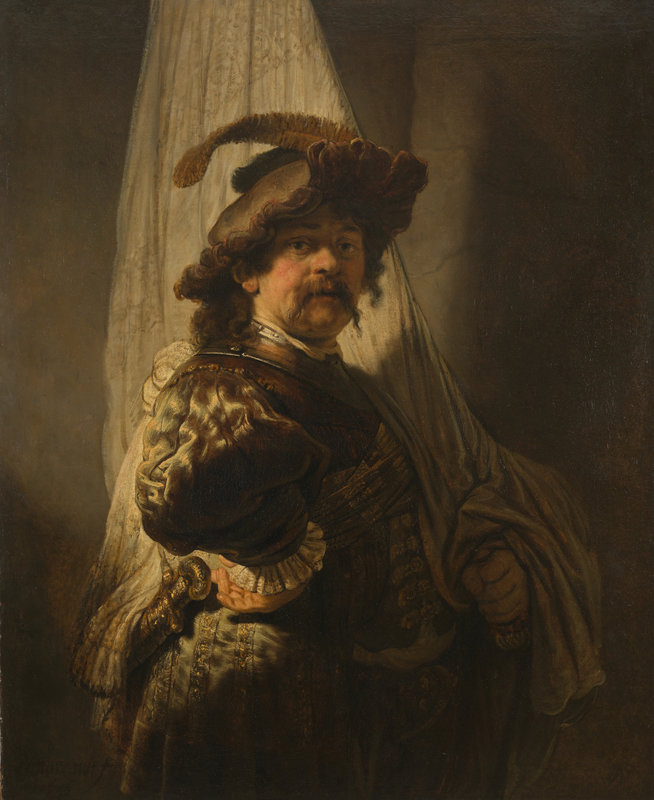16 juin 2023
Rembrandt's masterpiece on show at Rijksmuseum
Rembrandt van Rijn (1606–1669), The Standard Bearer, 1636. Rijksmuseum, Amsterdam.
AMSTERDAM.- Following a national tour, Rembrandt’s masterpiece The Standard Bearer (1636) is unveiled in the Gallery of Honour at the Rijksmuseum today where it will go on permanent display alongside the artist’s celebrated Night Watch (1642). The ceremony was performed by 8 classes of schoolchildren who have designed their own banners to celebrate the historic acquisition.
On Saturday 17 June the Rijksmuseum will be free for the day for people to see the painting which has recently been acquired for the national collection.
The Standard Bearer, one of the last masterpieces by Rembrandt which remained in private hands, was acquired for the Rijksmuseum thanks to a grant of €150m from the Dutch government and further contributions from the Rembrandt Association, the VriendenLoterij and the Rijksmuseum Fonds.
The Standard Bearer is inextricably linked to the history of the Netherlands. Standard-bearers were positioned ahead of the troops in the Eighty Years' War, the war of independence which led to the birth of the Netherlands in 1648. In this large self-portrait, Rembrandt paints himself looking rebellious and full of bravado. It was this artistic breakthrough that would lead to The Night Watch.
Taco Dibbits, General Director of the Rijksmuseum, said: “The Standard Bearer is one of the great self-portraits of Rembrandt and his artistic breakthrough. Proud and disarming at the same time it is a tribute to humanity. We are deeply grateful to all those who have made it possible to show it in the Gallery of Honour of the Rijksmuseum, for now and forever.”
The Standard Bearer (1636)
Rembrandt was thirty years old when he painted The Standard Bearer. He painted himself in historical clothing. He consciously places himself in the northern tradition of portraits of standard-bearers by famous artists such as Dürer, Lucas van Leyden and Goltzius.
Standard-bearers had a dangerous task within the militia in the 17th century: on the battlefield they accompanied the troops ahead of them in shiny clothing and brandishing flags. The militia had an essential role in the Eighty Years' War, the revolt against Spanish rule, which resulted in the birth of an independent Netherlands in 1648. At the same time, The Standard Bearer shows Rembrandt's ambition to paint a group portrait for the Amsterdam militia, at the time the most valued commission a painter could be awarded. Rembrandt succeeded six years later when he was commissioned to paint The Night Watch.
Rembrandt made about 340 paintings. Most of these are in foreign museums and private collections. There are 44 paintings by Rembrandt in the Netherlands, 22 of which are in the Rijksmuseum. The collection in the Netherlands, from his early self-portrait as a young man to his late self-portrait in the Mauritshuis in The Hague, provides an overview of his life. The Standard Bearer is one of the first paintings that Rembrandt made after he established himself as an independent artist in Amsterdam, and has so far been the missing link in this overview.
On Saturday 17 June the Rijksmuseum will be free for the day for people to see the painting which has recently been acquired for the national collection.
The Standard Bearer, one of the last masterpieces by Rembrandt which remained in private hands, was acquired for the Rijksmuseum thanks to a grant of €150m from the Dutch government and further contributions from the Rembrandt Association, the VriendenLoterij and the Rijksmuseum Fonds.
The Standard Bearer is inextricably linked to the history of the Netherlands. Standard-bearers were positioned ahead of the troops in the Eighty Years' War, the war of independence which led to the birth of the Netherlands in 1648. In this large self-portrait, Rembrandt paints himself looking rebellious and full of bravado. It was this artistic breakthrough that would lead to The Night Watch.
Taco Dibbits, General Director of the Rijksmuseum, said: “The Standard Bearer is one of the great self-portraits of Rembrandt and his artistic breakthrough. Proud and disarming at the same time it is a tribute to humanity. We are deeply grateful to all those who have made it possible to show it in the Gallery of Honour of the Rijksmuseum, for now and forever.”
The Standard Bearer (1636)
Rembrandt was thirty years old when he painted The Standard Bearer. He painted himself in historical clothing. He consciously places himself in the northern tradition of portraits of standard-bearers by famous artists such as Dürer, Lucas van Leyden and Goltzius.
Standard-bearers had a dangerous task within the militia in the 17th century: on the battlefield they accompanied the troops ahead of them in shiny clothing and brandishing flags. The militia had an essential role in the Eighty Years' War, the revolt against Spanish rule, which resulted in the birth of an independent Netherlands in 1648. At the same time, The Standard Bearer shows Rembrandt's ambition to paint a group portrait for the Amsterdam militia, at the time the most valued commission a painter could be awarded. Rembrandt succeeded six years later when he was commissioned to paint The Night Watch.
Rembrandt made about 340 paintings. Most of these are in foreign museums and private collections. There are 44 paintings by Rembrandt in the Netherlands, 22 of which are in the Rijksmuseum. The collection in the Netherlands, from his early self-portrait as a young man to his late self-portrait in the Mauritshuis in The Hague, provides an overview of his life. The Standard Bearer is one of the first paintings that Rembrandt made after he established himself as an independent artist in Amsterdam, and has so far been the missing link in this overview.
Publicité
Publicité
Commentaires

/https%3A%2F%2Fprofilepics.canalblog.com%2Fprofilepics%2F1%2F0%2F100183.jpg)
/https%3A%2F%2Fstorage.canalblog.com%2F03%2F02%2F119589%2F96711876_o.jpg)
/https%3A%2F%2Fstorage.canalblog.com%2F11%2F31%2F119589%2F94773502_o.jpg)
/https%3A%2F%2Fstorage.canalblog.com%2F20%2F83%2F119589%2F94772815_o.jpg)
/https%3A%2F%2Fstorage.canalblog.com%2F26%2F72%2F119589%2F75604929_o.jpg)
/https%3A%2F%2Fstorage.canalblog.com%2F59%2F60%2F119589%2F26458628_o.jpg)



/image%2F1371349%2F20240321%2Fob_0f526c_rembrandt-arms-akimbo.jpg)
/http%3A%2F%2Fstorage.canalblog.com%2F89%2F40%2F119589%2F129653656_o.jpg)
/http%3A%2F%2Fstorage.canalblog.com%2F77%2F49%2F119589%2F129539724_o.jpg)
/http%3A%2F%2Fstorage.canalblog.com%2F08%2F62%2F119589%2F128571574_o.jpg)